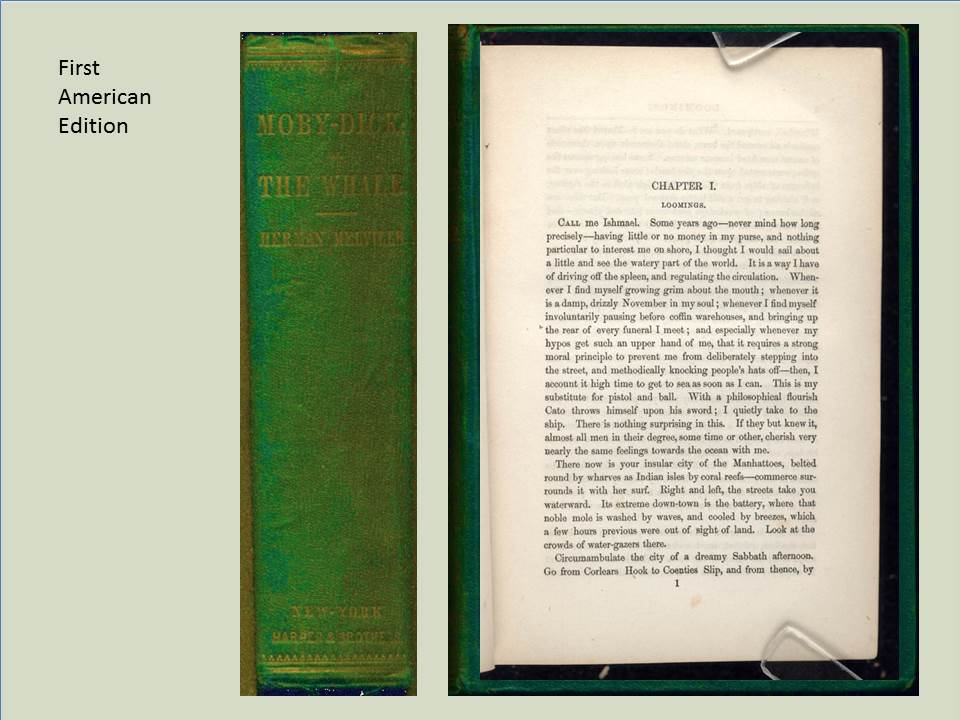Versions of Moby–Dick: A Fluid–Text Edition
 Melville’s most famous novel was written in an eighteen-month period
beginning soon after his return in January 1850 from his fall 1849 trip
to England and the Continent. In the midst of composing Moby-Dick, he
also purchased Arrowhead, a farm in Pittsfield, Massachusetts, adjacent
to his Uncle Thomas’s farm and farmhouse, Broadhall, where Melville had
spent many summer months as an adolescent. On a visit there, in August
of 1850, Melville met Nathaniel Hawthorne, who had taken temporary
lodging with his family in Lenox, Massachusetts, not far from
Pittsfield. One measure of the intellectual and aesthetic impact of this
friendship—evident in his review essay “Hawthorne and His Mosses,”
composed in August 1850, and in subsequent correspondence between the
two writers—is that Moby-Dick is dedicated to Hawthorne.
Melville’s most famous novel was written in an eighteen-month period
beginning soon after his return in January 1850 from his fall 1849 trip
to England and the Continent. In the midst of composing Moby-Dick, he
also purchased Arrowhead, a farm in Pittsfield, Massachusetts, adjacent
to his Uncle Thomas’s farm and farmhouse, Broadhall, where Melville had
spent many summer months as an adolescent. On a visit there, in August
of 1850, Melville met Nathaniel Hawthorne, who had taken temporary
lodging with his family in Lenox, Massachusetts, not far from
Pittsfield. One measure of the intellectual and aesthetic impact of this
friendship—evident in his review essay “Hawthorne and His Mosses,”
composed in August 1850, and in subsequent correspondence between the
two writers—is that Moby-Dick is dedicated to Hawthorne.
In fall 1850, Melville moved his family to Arrowhead, where in the spring and summer of 1851 he completed Moby-Dick and prepared it for publication as a single volume by Harper & Brothers in the US. At the same time, he sent slightly revised proof sheets to England, where his text was reset in three volumes and heavily expurgated by Melville’s British publisher Richard Bentley. Because no manuscript of Moby-Dick has survived, or yet emerged, its condition as a fluid text rests largely on the significantly different American and British first edition versions, Melville’s sources for the whaling novel, and on a range of adaptations to Melville’s text that have proliferated world culture since the Melville Revival of the 1920s.
MEL offers several editorial features that give readers access to the Versions of Moby-Dick. MEL’s Reading Text—designed as a platform from which readers can navigate to other versions of Melville’s fluid text—is a digitization of John Bryant and Haskell Springer’s 2006 Longman edition of Moby-Dick. This lightly edited text corrects typos in Melville’s first American edition and adds a handful of likely revisions that Melville made to the American proof sheets he sent to England. MEL editors used Juxta Editions to upload the Longman text and link it to individual pages of the American edition. They also added various kinds of contextual annotation, including the Longman annotations and new notes, composed by MEL editors, on Melville and the arts and Melville’s geographic imagination. Revision narratives displayed in the Longman print edition were also converted to digital revision narratives. Other features of the Longman edition, including a nautical glossary, whaling diagrams, a map of the Pequod’s voyage, lists of textual variants and emendations (corrections of typos), and additional revision annotation, await inclusion. In 2021, MEL’s Juxta Editions platform was updated to the more flexible critical editing platform FairCopy.
Versions of Moby-Dick also includes MEL’s Side-by-Side Display of the American and British First Editions as physical objects. Pop-down menus for each volume enable the reader to inspect bindings (cover, fore edge, and spine), front and back matter, and the print pages themselves, chapter by chapter. Comparing the two physical books demonstrates the different material conditions that shaped the initial American and British reading experiences of Moby-Dick. But a closer inspection of the textual expurgations (of words, sentences, paragraphs, chapters) can only be achieved through Collation (comparison) of the American and British texts and with the assistance of explanations offered in Revision Annotation (revision narrative). MEL initially performed such a collation using Juxta collation technology incorporated into an earlier instance of TextLab. TextLab’s collation feature, no longer operative, displayed both texts side-by-side, highlighted deleted and revised texts, and enabled editors to compose revision narratives of highlighted texts. This feature will be updated in FairCopy. Also “in the works” in Versions of Moby-Dick is the development of protocols for the content management and navigation of Adaptations of Moby-Dick. Currently our focus is on the 1956 John Huston and Ray Bradbury film adaptation titled “Moby Dick.” Our editing of Typee and “Benito Cereno” will facilitate the editing of adaptive revision.
Click on the links to the right for further introductory details on these editorial features.
 Tracking the Versions: Moby-Dick
Tracking the Versions: Moby-Dick